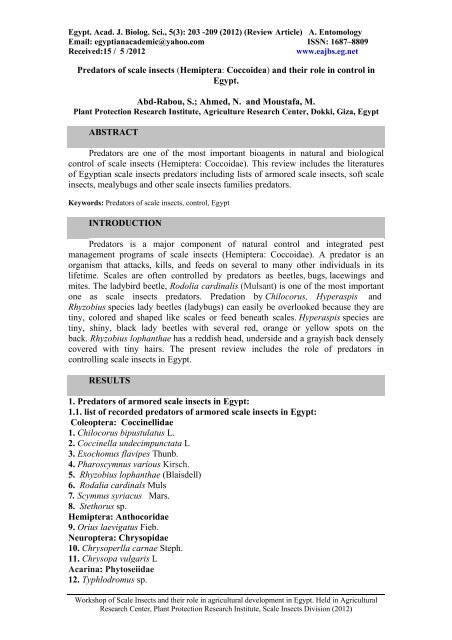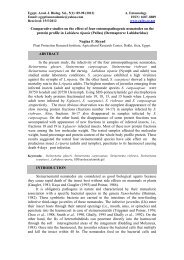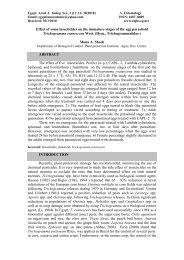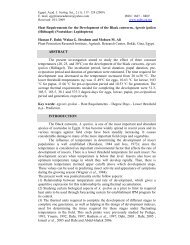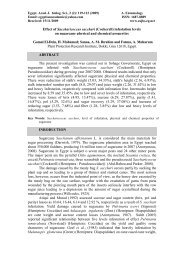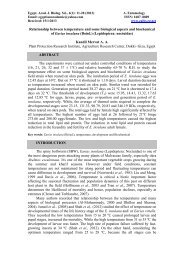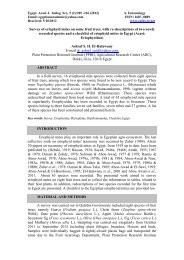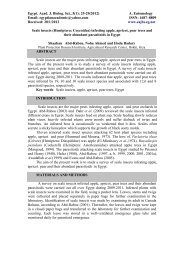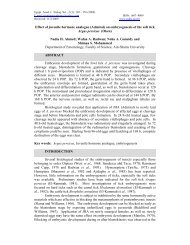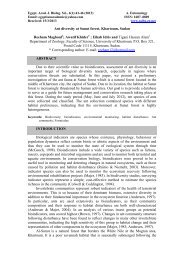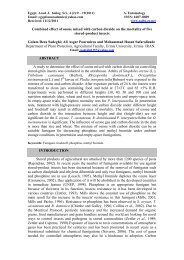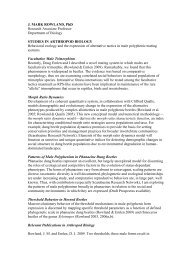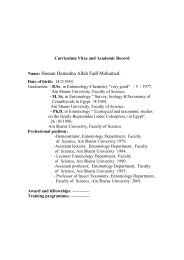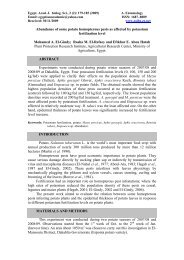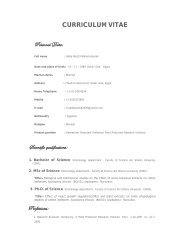Predators of scale insects - egyptian academic journal of biological ...
Predators of scale insects - egyptian academic journal of biological ...
Predators of scale insects - egyptian academic journal of biological ...
Create successful ePaper yourself
Turn your PDF publications into a flip-book with our unique Google optimized e-Paper software.
Egypt. Acad. J. Biolog. Sci., 5(3): 203 -209 (2012) (Review Article) A. Entomology<br />
Email: <strong>egyptian</strong><strong>academic</strong>@yahoo.com ISSN: 1687–8809<br />
Received:15 / 5 /2012 www.eajbs.eg.net<br />
<strong>Predators</strong> <strong>of</strong> <strong>scale</strong> <strong>insects</strong> (Hemiptera: Coccoidea) and their role in control in<br />
Egypt.<br />
Abd-Rabou, S.; Ahmed, N. and Moustafa, M.<br />
Plant Protection Research Institute, Agriculture Research Center, Dokki, Giza, Egypt<br />
ABSTRACT<br />
<strong>Predators</strong> are one <strong>of</strong> the most important bioagents in natural and <strong>biological</strong><br />
control <strong>of</strong> <strong>scale</strong> <strong>insects</strong> (Hemiptera: Coccoidae). This review includes the literatures<br />
<strong>of</strong> Egyptian <strong>scale</strong> <strong>insects</strong> predators including lists <strong>of</strong> armored <strong>scale</strong> <strong>insects</strong>, s<strong>of</strong>t <strong>scale</strong><br />
<strong>insects</strong>, mealybugs and other <strong>scale</strong> <strong>insects</strong> families predators.<br />
Keywords: <strong>Predators</strong> <strong>of</strong> <strong>scale</strong> <strong>insects</strong>, control, Egypt<br />
INTRODUCTION<br />
<strong>Predators</strong> is a major component <strong>of</strong> natural control and integrated pest<br />
management programs <strong>of</strong> <strong>scale</strong> <strong>insects</strong> (Hemiptera: Coccoidae). A predator is an<br />
organism that attacks, kills, and feeds on several to many other individuals in its<br />
lifetime. Scales are <strong>of</strong>ten controlled by predators as beetles, bugs, lacewings and<br />
mites. The ladybird beetle, Rodolia cardinalis (Mulsant) is one <strong>of</strong> the most important<br />
one as <strong>scale</strong> <strong>insects</strong> predators. Predation by Chilocorus, Hyperaspis and<br />
Rhyzobius species lady beetles (ladybugs) can easily be overlooked because they are<br />
tiny, colored and shaped like <strong>scale</strong>s or feed beneath <strong>scale</strong>s. Hyperaspis species are<br />
tiny, shiny, black lady beetles with several red, orange or yellow spots on the<br />
back. Rhyzobius lophanthae has a reddish head, underside and a grayish back densely<br />
covered with tiny hairs. The present review includes the role <strong>of</strong> predators in<br />
controlling <strong>scale</strong> <strong>insects</strong> in Egypt.<br />
RESULTS<br />
1. <strong>Predators</strong> <strong>of</strong> armored <strong>scale</strong> <strong>insects</strong> in Egypt:<br />
1.1. list <strong>of</strong> recorded predators <strong>of</strong> armored <strong>scale</strong> <strong>insects</strong> in Egypt:<br />
Coleoptera: Coccinellidae<br />
1. Chilocorus bipustulatus L.<br />
2. Coccinella undecimpunctata L<br />
3. Exochomus flavipes Thunb.<br />
4. Pharoscymnus various Kirsch.<br />
5. Rhyzobius lophanthae (Blaisdell)<br />
6. Rodalia cardinals Muls<br />
7. Scymnus syriacus Mars.<br />
8. Stethorus sp.<br />
Hemiptera: Anthocoridae<br />
9. Orius laevigatus Fieb.<br />
Neuroptera: Chrysopidae<br />
10. Chrysoperlla carnae Steph.<br />
11. Chrysopa vulgaris L<br />
Acarina: Phytoseiidae<br />
12. Typhlodromus sp.<br />
Workshop <strong>of</strong> Scale Insects and their role in agricultural development in Egypt. Held in Agricultural<br />
Research Center, Plant Protection Research Institute, Scale Insects Division (2012)
204<br />
Abd-Rabou, S. et al.<br />
1.2. Abundance <strong>of</strong> recorded predators <strong>of</strong> armored <strong>scale</strong> <strong>insects</strong> in Egypt:<br />
Osman (1971) found that Mycetaspis personata (Comstock) (Hemiptera:<br />
Diaspididae) was predated by Chrysopa vulgaris. Hamed and Fawzi (1991) carried<br />
out a survey on the predators <strong>of</strong> important <strong>scale</strong> <strong>insects</strong>. They recorded nine predators<br />
belonging to Coccinellidae and Chrysopidae. Eight predaceous insect species and<br />
seven predatory mite species were reported on branches infested with Parlatoria<br />
oleae Colvee from different host plants at different locations (Asfoor, 1997). Morsi<br />
(1999) recorded eleven predators and eight predacious mites on 7 armored <strong>scale</strong><br />
<strong>insects</strong>. Chilocorus bipustulatus L. (Coleoptera: Coccinellidae) was found to be the<br />
most promising predator <strong>of</strong> armored <strong>scale</strong> <strong>insects</strong> (Abd-Rabou, 2001). Predatory mite<br />
Typhlodromus sp. and coccinellid species were found associated with<br />
Aonidiella aurantii Maskell (Mohamed, 2002). Tawfik et al. (1970) recorded the<br />
insect predators associated with the black <strong>scale</strong>, Chrysomphalus ficus Ashmead in<br />
Egypt. These predators were C. bipustulatus, Scymnus syriacus Muls., Pharoscymnus<br />
varius Kirsch., R. cardinalis. The larvae <strong>of</strong> Chrysopa carnea Steph. (Neuroptera:<br />
Chrysopidae) and C. bipustulatus seemed to be the most important predators <strong>of</strong> this<br />
<strong>scale</strong> infesting citrus orchard. They were obtained in considerable numbers especially<br />
in May, June and August. Larvae and adults <strong>of</strong> these predators were observed feeding<br />
on different stages <strong>of</strong> C. ficus. R. cardinalis occurred in moderate numbers in infested<br />
citrus orchards. The latania <strong>scale</strong>, Hemiberlesia lataniae (Signoret) (Hemiptera:<br />
Diaspididae) had 9 species <strong>of</strong> predators. They were: C. bipustulatus, C. carnae,<br />
Coccinella undecimpunctata L, Exochomus flavipes Thunb. R. cardinals, Scymnus<br />
syriacus Mars. (Coleoptera: Coccinellidae); Orius laevigatus Fieb. (Hemiptera:<br />
Anthocoridae), Pharoscymnus various Kirsch. and Syrphus corollae Fabricius<br />
(Diptera: Syrphidae) (Moustafa and Abd-Rabou, 2011). The insect population <strong>of</strong><br />
Parlatoria oleae Leonardi (Hemiptera: Diaspididae) and the predator C. bipustulatus<br />
L. reached maximum during February and March over two years, respectively (Abd-<br />
Raboou and Ahmed, 2011).<br />
2. <strong>Predators</strong> <strong>of</strong> s<strong>of</strong>t <strong>scale</strong> <strong>insects</strong> in Egypt:<br />
2.1. List <strong>of</strong> recorded s<strong>of</strong>t <strong>scale</strong> <strong>insects</strong> predators in Egypt:<br />
Coleoptera : Coccinellidae<br />
1. Chilocorus bipustulatus L.<br />
2. Clitostethus arcuatus Rossi<br />
3.Coccinella septempunctata L.<br />
4.Coccinella undecimpunctata L<br />
5. Cydonia vicina isis Cr.<br />
6. Cydonia vicina nilotica Muls.<br />
7. Exochomus flavipes Thunb<br />
8. Pharoscymnus various Kirsch.<br />
9. Rhyzobius lophanthae (Blaisdell)<br />
10. Rhyzobius littura Fab.<br />
11. Rodalia cardinals Muls<br />
12. Scymnus interruptus Goeze<br />
13. Scymnus seriacus Mars.<br />
14. Stethorus sp.<br />
Coleoptera : Steaphilinidae<br />
15. Paederus alfierii Koch<br />
Diptera: Syrphidae<br />
16. Metasyrphus corollae Fab.<br />
17. Paragus compeaitus Wied.
<strong>Predators</strong> <strong>of</strong> <strong>scale</strong> <strong>insects</strong> (Hemiptera: Coccoidea) and their role in control in Egypt 205<br />
Hemiptera: Anthocoridae<br />
18. Orius laevigatus Fieb.<br />
19. Orius albidipennis (Reuter)<br />
Neuroptera: Chrysopidae<br />
20. Chrysoperlla carnae Steph.<br />
21. Chrysopa septempunctata Wesm.<br />
22. Chrysopa vulgaris aegyptica (Schneider)*<br />
Neuroptera: Phloeothripidae<br />
23. Haplothrips andresi Priesner<br />
2.2. Abundance <strong>of</strong> s<strong>of</strong>t <strong>scale</strong> <strong>insects</strong> predators in Egypt:<br />
Abd Allah (1988) recorded that coleopterous predators fed on s<strong>of</strong>t <strong>scale</strong>s<br />
infesting citrus, mango and ledge plants in Mansoura region were Cydonia vicina isis<br />
Cr., C. v. nilotica Muls., Coccinella septempunctata L., C. undecimpunctata, Scymnus<br />
interruptus Goez, S. cyriacus, Exochomus flavipes Thunb., R. cardinalis and<br />
Paederus alfierii Koch. He added two neuropetrous predators, C. carnea and C.<br />
septempunctata Wesm.; two hemipterous predators, Orius laevigatus Fieb. and O.<br />
albidipennis and two dipterous predators, Metasyrphus corollae Fab. and Paragus<br />
compeaitus Wied. The predators, C. bipustulatus, S. syriacus, Pharaoscymnus Varius<br />
Kirsch and R. cardinalis were found feeding on some s<strong>of</strong>t <strong>scale</strong> <strong>insects</strong>. Chrysop sp.<br />
larvae were very common and polyphagous predators feeding on many s<strong>of</strong>t <strong>scale</strong><br />
<strong>insects</strong> (Hamed and Hassanein, 1991). C. bipustulatus, S. syriacus, C. carnea, C.<br />
septempunctata and Orius laevigatus Fab. were recorded associated with different<br />
species <strong>of</strong> s<strong>of</strong>t <strong>scale</strong> <strong>insects</strong> in Kafr El-Sheikh (El-Agamy et al., 1994). El-Batan<br />
(1997) investigated the searching behavior <strong>of</strong> larvae <strong>of</strong> Exochomus flavipes<br />
(Thunberg) and C. carnea for Coccus hesperidum L. She found that larvae <strong>of</strong> C.<br />
carnea and early instars (1 st and 2 nd ) <strong>of</strong> E. flavipes showed equal searching capacity<br />
for C. hesperidum placed on both the top and bottom surfaces <strong>of</strong> galss plates. The 3 rd<br />
and 4 th larval instars <strong>of</strong> E. flavipes showed a preference for prey attached to the<br />
bottom surface. Before contacting prey, straved 3 rd instar larvae <strong>of</strong> C. carnea and 4 th<br />
instar larvae <strong>of</strong> E. flavipes searched relatively rapidly with a low turning rate. After<br />
contacting prey, searching speed decreased and turning rate increased by about double<br />
fold. Hendawy (1999) mentioned that the highest peak <strong>of</strong> s<strong>of</strong>t <strong>scale</strong> <strong>insects</strong> was<br />
detected in November, which coincided with the highest peak <strong>of</strong> predator. Then the<br />
population <strong>of</strong> predators gradually declined and peaked in May before the peak <strong>of</strong> <strong>scale</strong><br />
<strong>insects</strong>. However, the last peak <strong>of</strong> the predators occurred during August, directly after<br />
a peak <strong>of</strong> <strong>scale</strong> <strong>insects</strong>. He concluded that, peaks <strong>of</strong> <strong>scale</strong> <strong>insects</strong> and those <strong>of</strong> the<br />
predators were coincided. Scymnus syriacus Marseul was recorded as a predator <strong>of</strong> C.<br />
rusci (Morsi, 1999). Badari (2002) recorded 19 predators <strong>of</strong> Saissetia oleae Olivier<br />
and studied the population dynamics <strong>of</strong> six <strong>of</strong> them. They were C. bipustulatus, C.<br />
carneae, C. undecimpunctata (L.), E. flavipes, Orius sp. and Scymnus<br />
syriacus Marseul. Two peaks were recorded annually for C. bipustulatus and C.<br />
undecimpunctata while one peak in case <strong>of</strong> C. carnae and S. syriacus, E. flavips and<br />
Orius sp. were recorded as a low population throughout the two years under<br />
considerations. Badary (2011) stated taht genus Saissetia was recorded associated<br />
with 16 predator species. Numbers by the predator Scymnus syriacus Mars.,<br />
(Coleoptera: Coccinellidae) reached maximum (2/60 leaves) during August, in the<br />
first year and during September in the second year. The predators, Coccinella<br />
undecimpunctata L. and E. flavipes reached maximum <strong>of</strong> 5.8 and 28/ 60 leaves and<br />
30 twigs during September and August, in the first year, respectively and 24, 19.4<br />
and 22 / 60 leaves and 30 twigs during September in the second year, respectively.
206<br />
Abd-Rabou, S. et al.<br />
Abd-Rabou and Badary (2010) recorded the predator, S. syriacus on the niger <strong>scale</strong>,<br />
Parasaissetia nigra (Nietner) (Hemiptera: Coccidae) in Egypt.<br />
The abundance <strong>of</strong> the predator, S. syriacus <strong>of</strong> Saissetia c<strong>of</strong>feae (Walker)<br />
(Hemiptera: Coccidae) reached maximum during October during two successive<br />
years. The predator E. flavipes (Coleoptera: Coccinellidae) reached maximum during<br />
October during two successive years, respectively (Abd-Raboou and Ahmed, 2011).<br />
2.3. Applied biocontrol using predators <strong>of</strong> s<strong>of</strong>t <strong>scale</strong> <strong>insects</strong> in Egypt:<br />
Six releases <strong>of</strong> the predator, E. flavipes on the green shield <strong>scale</strong>, Pulvinaria<br />
psidii Maskell (Hemiptera: Coccidae) on guava trees in Gahrbiya was conducted.<br />
This predator was reared under defined climatic conditions (25–27°C and 65–75%<br />
RH) in the laboratory. A significant reduction in the number <strong>of</strong> P. psidii population<br />
was recorded compared with control plots. Six months after the release, the average<br />
population <strong>of</strong> P. psidii was decreased from 1897 to 475/30 leaves in the treated plot.<br />
The present study indicated that E. flavipes is a potential biocontrol agent <strong>of</strong> P. psidii.<br />
on guava in Egypt (Abd-Rabou, 2011).<br />
3. <strong>Predators</strong> <strong>of</strong> mealybugs in Egypt:<br />
3.1. List <strong>of</strong> reported predators <strong>of</strong> mealybugs in Egypt:<br />
Coleoptera : Coccinellidae<br />
1. Cryptolaemus montrouzieri Mulsant<br />
2. Rodolia cardinalis (Muls.)<br />
3. Scymnus interruptus Goeze<br />
4. Scymnus seriacus Mars.<br />
Diptera: Cecidomyiidae<br />
5. Diadiplosia sp.<br />
Lepidoptera: Noctuidae<br />
6. Autoba beraudi Joannis<br />
7. Autoba gayncri Rothsch<br />
8. Rivula sericealis Scop.<br />
Lepidoptera: Oecophoridae<br />
9. Stathmopoda auriferella Mayr.<br />
Neuroptera: Chrysopidae<br />
10. Chrysopa vulgaris aegyptica (Schneider)<br />
3.2. Abundance <strong>of</strong> predators <strong>of</strong> mealybugs in Egypt:<br />
Osman (1972) recorded R.cardinals as a predator <strong>of</strong> the margarodid,<br />
Icerya purchasi Maskell. The predators, Scymnus includens Kirch, Cryptolaemus<br />
montrouzieri Muls, C. carnae, Sympherobius amicus Navas and Hyperaspis<br />
vincigurrae associated with the pseudococcid F. virgata (Rashad, 1975). The<br />
predators, Scymnus interruptus Goez. and P. varius were recorded associated with<br />
Pseudococcus sp. (Osman, 1977). Hamid and Hassanian (1991) recorded S.<br />
interruptus associated with Saccharicoccus sacchari (Cockerell) and R. cardinals<br />
associated with the margarodids, I. purchasi and Icerya spp. Moustafa (2012)<br />
recorded R. cardinalis associated with the seychellarum mealybug, Icerya<br />
seychellarum (Westwood) on citurs trees in Demmyat. Nine species <strong>of</strong> predators<br />
were recorded to attacke the citrus mealy bug, Planococcus citri (Risso) (Hemiptera:<br />
Pseudococcidae). These species were 3 coleopteran species, one dipteran, four<br />
lepidopterans and one neuropteran (Ahmed and Abd-Rabou, 2010).<br />
3.3. Applied biocontrol using predators <strong>of</strong> mealybugs in Egypt:<br />
Biological control measures against mealybugs using C. montrouzieri started in<br />
1926. It was reared and distributed on a limited <strong>scale</strong> (as its rearing was time<br />
consuming). The insect fed freely on various species <strong>of</strong> mealybugs. Due to its low
<strong>Predators</strong> <strong>of</strong> <strong>scale</strong> <strong>insects</strong> (Hemiptera: Coccoidea) and their role in control in Egypt 207<br />
reproductive potential, slow spreading, the necessary protection to stand our winter<br />
condition and the annual release <strong>of</strong> new colonies, the work on this predator species<br />
was abandoned (Kamal, 1951). Second trial to introduce and rear this coccinellid<br />
predator from France to Egypt was conducted. Releasing C. montrouzieri against the<br />
striped mealybug, Ferrisia virgata gave a positive effect in reduction <strong>of</strong> the mealybug<br />
population. The percent <strong>of</strong> reduction reached to 100.0, 98.9 and 94.4% for crawlers,<br />
nymphs and adults <strong>of</strong> F. virgata, respectively after 3 months <strong>of</strong> release (Attia and El<br />
Arnaouty, 2007). The coccinellid predator, C. montrouzieri was used to control the<br />
citrus mealybug, Planococcus citri (Risso.) (Hemiptera: Pseudococcidae) on the<br />
croton ornamental shrubs, Codiaeum variegatum L. at Giza governorate, Egypt. C.<br />
montrouzieri as 50 adults/Croton shrub, were released once on October 27, 2008 in<br />
the open field. Obtained results indicated that percentages <strong>of</strong> reduction among the egg<br />
masses, nymphs and adults <strong>of</strong> P. citri, one month after releasing the predator reached<br />
to 41.5, 42.3 and 57.5%, respectively. Two months later, the corresponding rates were<br />
80.6, 86.5 and 91.5%. Finally, after three months <strong>of</strong> releasing the predator, reduction<br />
rates reached to 100% for all stages <strong>of</strong> the pest (Afifi et al., 2010).<br />
4. <strong>Predators</strong> <strong>of</strong> other families <strong>of</strong> <strong>scale</strong> <strong>insects</strong>:<br />
Moustafa (2012a) recorded two species <strong>of</strong> predators attacked the red date<br />
<strong>scale</strong>, Phoenicococcus marlatti Cockerell (Hemiptera:Phoenicococcidae). These<br />
species belonging to Order: Coleoptera, Family Coccinellidae, Pharoscymnus varius<br />
(Kirsch) and Scymnus punetillum Weise. The predator recorded in El-Arish region<br />
was P. varius. During the first year (2009-2010). No occurrence <strong>of</strong> predators was<br />
noticed from October 15 th 2009 to February 15 th 2010. The population reached its<br />
maximum numbers <strong>of</strong> individuals as 62 individuals /sample. During the second year<br />
(2010-2011) no occurrence <strong>of</strong> predators was noticed from November 1 st to February<br />
15 th 2011. The population reached maximum numbers <strong>of</strong> individuals 58 individuals<br />
per samples. Ahmed (2011) recorded three species <strong>of</strong> predators attacked Pollinia<br />
pollini (Costa) (Hemitera: Asterolecanidea) in Egypt. These were the coccinelids,<br />
Coccinella undecimpunctata L., Scymnus seriacus Mars. and the Neuroptera species,<br />
C. carnae Moustafa and Abd-Rabou (2010) recorded seven species <strong>of</strong> predators<br />
attacked, the guava s<strong>of</strong>t <strong>scale</strong>, Pulvinaria psidii (Maskell) (Hemiptera : Coccidae) .<br />
REFERENCES<br />
Abd-Rabou, S. (2007): Biological control <strong>of</strong> Saccharicoccus sacchari (Coccoidea :<br />
Pseudococcidae) on sugar cane in Egypt by using imported and indigenous<br />
natural enemies. Proceedings <strong>of</strong> the XI International Symposium on Scale Insect<br />
Studies, pp. 277-284.<br />
Abd-Rabou, S. (2011): Field efficacy <strong>of</strong> parasitoid, Coccophagus scutellaris<br />
(Hymenoptera: Aphelinidae) and the predator, Exochomus flavipes (Coleoptera:<br />
Coccinellidae) against Pulvinaria psidii (Hemiptera: Coccidae) in Egypt. J.<br />
Biological Control, 25 (2): 85–91.<br />
Abd-Rabou, S. and Abbassi, M. (2009): Survey and taxonomy <strong>of</strong> the main pests and<br />
their natural enemies attacking citrus and olive in Egypt and Morocco in costal<br />
areas with special keys to the pests and their natural enemies. J. Agri. Sci.<br />
Mansoura Univ., 34(10): 10179-10189.<br />
Abd-Rabou, S. and Ali , N. (2009): Seasonal abundance <strong>of</strong> Pulvinaria psidii<br />
(Hemiptera: Coccidae) and its predator, Exochomus flavipes (Coleoptera:<br />
Coccinellidae) in Egypt. J. Egypt-Ger. Soc. Zool. 58E: 1-18.
208<br />
Abd-Rabou, S. et al.<br />
Abd-Rabou, S. and Ahmed, N. (2011): Seasonal incidence <strong>of</strong> <strong>scale</strong> <strong>insects</strong>, whiteflies<br />
and psyllids (Hemiptera) <strong>of</strong> olive and their natural enemies in Egypt. Egypt.<br />
Acad. J. biolog. Sci., 4 (1): 59 - 74.<br />
Abd-Rabou, S. and Badary, H. (2010): Survey <strong>of</strong> <strong>scale</strong> <strong>insects</strong> infesting mango trees<br />
in Egypt with emphasis on population dynamics <strong>of</strong> Parasaissetia nigra<br />
(Nietner) (Hemiptera: Coccidae) and its natural enemies as a new record for<br />
this crop. The 5th Scientific Conference for Agricultural Sciences, Fac. Agric.<br />
Assiut Univ. 195-210.<br />
Abd-Rabou, S. and Badary, H. (2004): Survey and abundance <strong>of</strong> natural enemies <strong>of</strong><br />
the cottony camellia <strong>scale</strong>, Pulvinaria floccifera (Homoptera: Coccidae) in<br />
Egypt. Annals <strong>of</strong> Agric. Sci., Moshtohor, 42 (2):831-838.<br />
Abd-Rabou, S. and Badary, H. (2005): Natural enemies <strong>of</strong> the s<strong>of</strong>t brown <strong>scale</strong>,<br />
Coccus hesperidum L. (Homoptera: Coccidae) in Egypt. Egypt. J. Agric.Res.83<br />
(1): 77-87.<br />
Abd-Rabou, S. and El-Naggar, M. (2004): <strong>Predators</strong> <strong>of</strong> armored <strong>scale</strong> <strong>insects</strong><br />
(Homoptera: Diaspididae) in Egypt. Proceeding <strong>of</strong> the X International<br />
Symposium on Scale Insect Studies.Page:267.<br />
Abd-Rabou, S. and Mohamed, G.H. (2007): Survey <strong>of</strong> <strong>scale</strong> <strong>insects</strong> (Coccoidea)<br />
infesting date palm and their natural enemies in Egypt Egypt. J. Agric.Res.<br />
,85(1): 91- 97.<br />
Abd-Rabou, S. and Moustafa, M. (2012): Natural enemies <strong>of</strong> the white peach <strong>scale</strong>,<br />
Pseudaulacaspis pentagona (Hemiptera : Diaspididae) in Egypt. J. Egypt. Ger.<br />
Soc. Zool. Vol. ( 64E): Entomology, 59-77.<br />
Abd Allah, L. A. (1988): Studies on predator and parasite <strong>insects</strong> attacking <strong>scale</strong><br />
<strong>insects</strong> and mealybugs in Dakahlia Governorate. Ph. D. Thesis, Fac. Agric.,<br />
Mansoura Univ.<br />
Ahmed, N. (2012): Bionomics <strong>of</strong> Pollinia pollini (Costa) (Hemiptera:<br />
Asterolecanidae) in Egypt. J. Egypt. Ger. Soc. Zool. Vol. ( 64E): Entomology<br />
(In Press).<br />
Ahmed, N. and Abd-Rabou, S. (2010): Host plants, geographical distribution, natural<br />
enemies and <strong>biological</strong> studies <strong>of</strong> the citrus mealybug, Planococcus citri (Risso)<br />
(Hemiptera: Pseudococcidae). Egypt. Acad. J. Biolog. Sci., 3(1): 39-47.<br />
Afifi, A. I.; El Arnaouty, S. A.; Attia, A. R. and EL-Metwally, A. (2010): Biological<br />
Control <strong>of</strong> citrus mealybug, Planococcus citri (Risso.) using coccinellid<br />
predator, Cryptolaemus montrouzieri Muls. Pakistan J. <strong>of</strong> Biological Sciences,<br />
13: 216-222.<br />
Asfoor, M. A. (1997): Seasonal abundance and control <strong>of</strong> the plum <strong>scale</strong> insect,<br />
Parlatoria oleae (Clovee') on some deciduous trees. Ph. D. Thesis, Fac. Agric.<br />
Zagazig University, 398 pp.<br />
Attia, A.R. and S.A. El-Arnaouty, (2007): Use <strong>of</strong> the coccinellid predator,<br />
Cryptolaemus montrouzieri Mulsant against the striped mealybug, Ferrisia<br />
virgata (Ckll.) on the ornamental plant, Acalypha macrophylla in Egypt. Egypt.<br />
J. Biol. Pest Control, 17: 71-76.<br />
Badary, H. (2010): Ecological aspects <strong>of</strong> Sassetia spp. (Coccidae: Coccoidae:<br />
Hemiptera) and thier natural enemies in Egypt. Egypt. Acad. J. biolog. Sci., 4<br />
(1): 163-174 .<br />
Badary, H. and Abd-Rabou, S. (2010): Biological studies <strong>of</strong> the California red <strong>scale</strong>,<br />
Aonidiella aurantii (Maskell) (Hemiptera: Diaspididae) under different host<br />
plants and temperatures with an annotated list <strong>of</strong> natural enemies <strong>of</strong> this pest in<br />
Egypt. Egypt. Acad. J. biolog. Sci., 3 (1): 235 - 242.
<strong>Predators</strong> <strong>of</strong> <strong>scale</strong> <strong>insects</strong> (Hemiptera: Coccoidea) and their role in control in Egypt 209<br />
El-Agamy, F. M.; Metwally, S. M. I.; Shawer, M. B. and Metwally, M. M. (1994):<br />
The role <strong>of</strong> parasitoids in the control <strong>of</strong> Florida wax <strong>scale</strong>, Ceroplastes<br />
floridensis Comst. in Kafr El-Sheikh Governorate, Egypt, J. Agric. Res. Tanta<br />
Univ., 20 (1): 58-64.<br />
El-Batran, L. A. (1997): Laboratory studies on searching behavior <strong>of</strong> larvae <strong>of</strong><br />
Exochomus flavipes (Thunb.) and Chrysoperla carnea (Steph.) for Coccus<br />
hesperidum L. Egypt. J. Biol. Pest Control, 7 (2): 103-5.<br />
Hendawy, A. S. (1999): Studies on certain natural enemies <strong>of</strong> <strong>scale</strong> <strong>insects</strong> attacking<br />
guava trees at Kafr El-Sheikh governorate. Ph. D. Thesis, Fac. Of Agric., Tanta<br />
University, pp 145.<br />
Kamal, M., (1951): Biological projects in Egypt with a list <strong>of</strong> introduced parasites and<br />
predators. Bull. Soc. Fouad Entomol., 35: 205-220.<br />
Mohamed, A. A. (2002): Integrated control <strong>of</strong> <strong>scale</strong> <strong>insects</strong> on certain fruit trees. Ph.<br />
D. Thesis, Fac. <strong>of</strong> Agric., Al-Azhar University, 173 pp.<br />
Morsi, G. A. (1999): Studies on the natural enemies <strong>of</strong> <strong>scale</strong> <strong>insects</strong> infesting some<br />
fruit trees. Ph. D. Thesis, Benha Branch, Zagazig University, pp. 235.<br />
Moustafa, M. (2012a): Host plant, distribution and natural enemies <strong>of</strong> the red date<br />
<strong>scale</strong>, Phoenicococcus marlatti Cockerell (Hemiptera: Phoenicococcidae) and its<br />
infestation status in Egypt. J. Egypt. Ger. Soc. Zool. Vol. (64E): Entomology (In<br />
Press).<br />
Moustafa, M. (2012b): Scale <strong>insects</strong> (Coccoidae: Hemiptera) infested citrus trees and<br />
thier natural enemies, with a key <strong>of</strong> these pests in Egypt. Egypt. Acad. J. biolog.<br />
Sci., 5(1): 1- 23.<br />
Moustafa, M. and Abd-Rabou, S. (2010): Bionomics <strong>of</strong> the guava s<strong>of</strong>t <strong>scale</strong> insect,<br />
Pulvinaria psidii (Maskell) (Hemiptera : Coccidae) in Egypt. Egypt, J. Agric.<br />
Res., 88 (4): 1141-1152.<br />
Moustafa, M. and Abd-Rabou, S. (2011): Natural enemies <strong>of</strong> the latania <strong>scale</strong>,<br />
Hemiberlesia lataniae (Hemiptera: Diaspididae) in Egypt. Egypt. Acad. J.<br />
biolog. Sci., 4 (1): 75-90.<br />
Osman, M. A. O. (1977): Biological control <strong>of</strong> <strong>scale</strong> <strong>insects</strong> in Beheira and Kafr El-<br />
Sheikh Provinces. Ph.D. Thesis, Fac. Agric., Al-Azhar Univ., Egypt.<br />
Rashad, A. M. (1975): Studies <strong>of</strong> the morphology, biology and ecology <strong>of</strong> the white<br />
mealybug, Ferrisia virgata Cockerell (Pseudococcidae : Homoptera) in Egypt.<br />
M. Sc. Faculty <strong>of</strong> Agriculture, Cairo University, 170 pp.<br />
Tawfik, M. f. S.; Hafez, M. and Raouf, A. H. (1970): Survey <strong>of</strong> the natural enemies <strong>of</strong><br />
the balck scael, Chrysompalus ficus (Ashm.), in the world and ARE. Minst.<br />
Agric. Egypt, Tech. Bull., 2: 19-31.<br />
رصم ىف ةحفاكملا<br />
ARABIC SUMMARY<br />
ىف اھرودو ةيرشقلا تارشحلا تاسرتفم<br />
ىفطصم ىنم و دمحأ اھن و هبردبع نابعش<br />
رصم – ةزيج -ىقدلا<br />
– ةيعارزلا ثوحبلا زكرم – تاتابنلا ةياقو ثوحب دھعم<br />
لاقملا<br />
اذھ . ةيرشقلا تارشحلل ةيجولويبلا ةحفاكملا و ةعيبطلا ىف ةيجولويبلا رصانعلا مھأ نم تاسرتفملا<br />
ىقيقدلا قبلا و ةوخرلا تارشحلا و ةحلسملا ةيرشقلا تارشحلا تاسرتفمب ةقلاع اھل ىتلا ةيملعلا عجارملا نمضت<br />
.<br />
رصم ىف ىرخلأا ةيرشقلا تارشحلا لئاصف ضعبو


